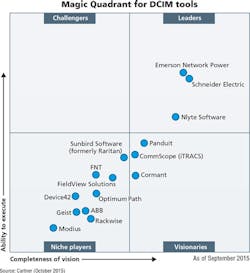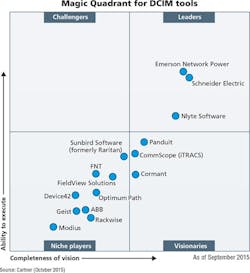More than alphabet soup, AIM and DCIM strive to provide tangible value to users
By Patrick McLaughlin
Automated infrastructure management (AIM) may be a relatively new term to professionals in the structured cabling industry, but the technology at the core of AIM has been commercially available for about two decades. Before the term AIM was settled on and bona fide standards-development efforts were underway to specify the technology, industry personnel heard and used terms including “intelligent patching,” “intelligent infrastructure management,” and “intelligent physical layer management.”
As terminology evolved, so did systems’ capabilities and market penetration. In late 2014 Nexans (www.nexans.com) authored a document titled “AIM Systems Explained,” in which it discussed the dichotomy of user attitudes toward the technology. “The range of opinions is extreme,” the company explained. “At one end are those who will pay almost any premium to have what they see as a ‘must-have’ technology, and at the other, end users and IT consultants who wouldn’t have an AIM system if it was free.” Nexans said hindrances to adoption included the tendency by some providers to oversell AIM’s capabilities, but also identified as a key barrier “difficulty in specifying or scoping an AIM system … this situation has multiple facets. The scope of any AIM deployment needs careful thought and clear documentation; there is a requirement for the end user or consultant to clearly set out what is wanted and for the integrator to understand these requirements and quote accurately for their delivery.”
The company uses the term “expectation gap” several times as it lays out typical examples of each side of the business arrangement having different visions of the outcome. “To get it right takes time and commitment,” Nexans said. “It is easy to get stuck in a vicious cycle of, ‘What can it do?’ ‘What do you want it to do?’”
Getting standardized
The paper points to the standard-development initiatives taken by the International Organization for Standardization/International Electrotechnical Commission (ISO/IEC) as an effort to break down barriers between AIM system providers and users. Specifically, the ISO/IEC drafted an amendment to its 14763-2 Cabling System Administration standard “with an Annexe now containing a specification of the minimum requirements of an AIM system …” CENELEC’s EN 50174-1 specification included similar language. Nexans commented, “This is a huge step forward as it at least allows an end user/consultant to request a quote for an AIM in accordance with these Annexes, which levels the playing field.”
The company then credits ISO/IEC for advancing the cause further with the drafting of ISO/IEC 18598 Automated Infrastructure Management-Requirements, Data Exchange and Applications. The standard is not yet completed but could be in early 2016. Nexans explained, “This new AIM standard contains-in addition to the usual scope, definitions and abbreviations-three important sections. Clause 5 details the requirements and recommendations for a ‘standard’ AIM system; Clause 6 details the applications and benefits of standalone AIM systems and goes on to describe some potential benefits of AIM systems when connected to other management systems; and finally Clause 7 addresses the interface necessary to allow information exchange with other systems.”
The company describes Clause 6 as “unusual for an ISO/IEC standard in that it deliberately contains no requirements and is entirely tutorial, which is usually to be avoided. It is, however, the clause that provides the ‘Why’ for AIM and links the requirements of Clause 5 to applications and benefits, and discusses such aspects as: managing and utilizing assets, automatic infrastructure documentation and monitoring, event management and alerting, and the deployment of new services. It also discusses process management, infrastructure security management and discovery, and configuration of attached equipment.”
The Telecommunications Industry Association (TIA) will publish AIM specifications as Addendum 1 to its ANSI/TIA-606-B standard. The TIA has followed the ISO/IEC’s progress on its 18598 standard and essentially has taken that standard organization’s lead.
AIM and DCIM
AIM is sometimes used in the same context with-and in fact, is sometimes confused with-data center infrastructure management (DCIM), though the two technologies are not the same. As Belden’s (www.belden.com) product line manager Kristen Poulos recently pointed out in a blog post, “Data center managers now have a number of options for turning a once-very-manual error-prone process into one that is efficient and intelligently managed. Whether it’s a DCIM, AIM, IIMS [intelligent infrastructure management system], IPLMS [intelligent physical layer management system] or intelligent patching solution, these solutions all strive for one goal: to provide a real-time view of the network to quickly identify incidents, automate routine tasks and help managers better understand capacity. They can also help managers better monitor network security and reduce energy consumption through optimum density mapping.”
Exactly which type of technology does what can be challenging to sort out. Belden’s Poulos explained that DCIM solutions “can range from software solutions to full-scale hardware, software and sensor solutions,” while AIM “includes both the hardware that automatically detects insertion or removal of patch cords, such as an intelligent patch panel, and the software that collects, stores and communicates this information.”
Similarly, CommScope (www.commscope.com) product manager Blake Van Scoy blogged, “If your organization is using an AIM-based intelligent connectivity management solution-either on its own or as an integral part of a DCIM suite-questions [about locations and connectivity of network assets] are easy to answer. AIM is an emerging ISO/IEC standard that defines the management of structured cabling, patching, and network connectivity. An intelligent connectivity management solution leveraging the AIM standard is an ideal tool to automatically track patching activities and report all changes to the physical layer. Network devices can communicate with switches and routers to update location-based moves, adds and changes as well as IP or server names based on the physical layer information. This offers decision makers real-time visibility into the status and disposition of connectivity changes as they occur.
“An AIM-based intelligent connectivity management solution should be considered an integral part of any best-in-class DCIM suite to strengthen the intelligent, real-time management of the physical infrastructure,” Van Scoy continued. “With a true DCIM solution, users have comprehensive command-and-control over both IT and facilities resources. Any data point can be fed into the suite or from the suite using open, industry-standard interfaces and protocols. Data can be collected, aggregated, managed and visualized in real time from virtually any source. It is a software suite, unrestrained by hardware legacies or point products that constrain data exchange.”
Deep analysis
Analyst firms Gartner and IDC both recently examined DCIM and issued reports on the space’s market as well as technology advancements.
In its report “Magic Quadrant for Data Center Infrastructure Management Tools,” Gartner explained, “DCIM tools monitor, measure, manage and/or control data center resources and energy consumption of both IT-related equipment (such as servers, storage and network switches) and facilities infrastructure components (such as power distribution units and computer room air conditioners). DCIM tools are data-center-specific (they are designed for data center use), rather than general building management system tools, and are used to optimize data center power, cooling and physical space.”
The report goes into significant detail on market conditions as well as strengths and cautions of DCIM systems offered by 15 providers. As part of its analysis, Gartner stated that DCIM benefits “are better-understood than they were a year ago, and as a result, there has been a gradual, overall increase in DCIM investments, although DCIM adoption patterns do vary by organization size and geography.” The analyst later added, “Price, ease of deployment, and overall ease of use continue to be some of the biggest concerns customers have when selecting a DCIM vendor and product. They are also among the top reasons why some organizations are choosing not to deploy DCIM, yet or at all.”
Bragging rights
Appearance in Gartner’s Magic Quadrant has become a notable bragging right among vendors in any IT sphere. In analyzing technologies-DCIM in this case-Gartner rates each vendor’s offering according to its completeness of vision on one axis (the X axis) and according to its ability to execute on the other axis (the Y axis). Each axis is divided in the middle, so the entire plot is divided into quadrants. Offerings that climb more than halfway up each axis land in the Leaders quadrant. Those more than halfway up the vision axis but less than halfway up the execution axis are in the Visionaries quadrant. Those on the lower half of each axis are in the Niche Players quadrant. In its most recent report, issued in October, Gartner did not place any DCIM vendor in the Challengers quadrant, which comprises the top half of the execute axis and the bottom half of the vision axis. A graph within this article shows where Gartner placed each of the 15 vendors it analyzed.
Naming the leaders
Similarly and also in October, IDC issued its report “IDC MarketScape: Worldwide Data Center Infrastructure Management 2015 Vendor Assessment.” Its ratings qualify the 15 vendors’ strategies and capabilities and characterizes analyzed vendors, in descending order, as Leaders, Major Players, Contenders and Participants. Its 2015 assessment included one Contender and no Participants.
An excerpt from the document states, “The ultimate goal of a data center is to deliver IT services to end customers, and data center managers are under increasing pressure to deliver this service quickly, wherever and whenever needed, without compromising uptime and reliability. DCIM, when implemented well and supported across the enterprise, can be a critical step in delivering data center resources ‘as a service’ to customers … Selecting the most appropriate DCIM solution should start with an assessment of the future strategy for delivering IT service to customers. With many enterprise IT organizations moving toward a distributed data center strategy, where the data center is a collection of resources (owned or colocated) in the different regions in which the company does business, it will be important to select a solution that can be localized to the region and also a services organization that can deploy and maintain the solution in all geographies … The ability of a DCIM provider to enable secure connections and automate tasks becomes a competitive differentiator.”
IDC further identified three key criteria that organizations should consider when evaluating DCIM vendors: 1) The ability to integrate and interact with many other management tools in the data center; 2) Scalability of the solution to encompass very large sets of data from many data center types (on-premises, edge, and colocated); 3) Investment in predictive analytics and automation technologies to enable the lights-out data center.
Jennifer Koppy, IDC’s research director for data center trends and strategies, commented, “DCIM is a collection of tools to increase the visibility into and control over data center resources from the critical facilities layer up through to the IT management layer. The providers in this space approach these management challenges in different ways. As organizations investigate a software-defined approach to IT architecture, the inclusion of solutions such as DCIM that enable visibility through the critical facilities layer should be considered. This research uncovers the breadth and scope of the providers’ offerings and their strategies for enabling data center resources to be viewed as pools of resources to enable greater agility and flexibility.”
Automated infrastructure management and data center infrastructure management are distinct technologies and, as the detail in this article shows, perform quite different functions. Yet they are similar in that, like just about any technology, they require careful consideration to determine their appropriateness for a given situation before they are implemented.
When implementing either type of solution, a user organization may expect its vendor to play a hands-on role in setup and launch. The soft cost of a user’s effort to get the system working easily could be underestimated.
Patrick McLaughlin is our chief editor.


